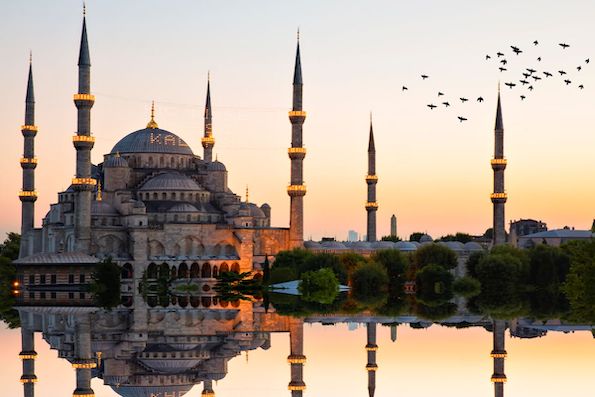The Blue Mosque is the largest mosque in Istanbul and a religious symbol for Muslims visiting the city. It is considered one of the masterpieces of the Islamic world and one of Istanbul’s greatest architectural creations. It was built by Sultan Ahmed I in 1609-1616 on the shore of the Sea of Marmara, on a hill opposite the Hagia Sophia church. In fact, the mosque is the core of a large complex, initially known as the Sultan Ahmed Mosque, but renamed the Blue Mosque due to the blue tiles that adorn its walls. The complex also consists of tombs, medreses (buildings for teaching Islam), a hospital, a covered market (bazaar), baths, fountains, public kitchens for cooking food for the poor, warehouses, halls and, of course, the tomb of Sultan Ahmed I
The Blue Mosque was built in a large courtyard with five gates. The main entrance gate is located in front of the Hippodrome. Its outer courtyard surrounds the mosque building and the inner courtyard of the complex. It has three entrances leading into the inner courtyard (two on each inch outside the main building and one opposite the entrance to the main building). There are two other entrances on either side of the mosque, which lead directly into the main building.
Upon entering the inner atrium, which is surrounded by a portico with 26 columns and 30 domes, you can see a small washing fountain. There are three entrances to the mosque (two on each side and one through the inner courtyard) inside which visitors can admire the colored tiles, the window panes and the harmonious decoration of a holy place. Six minarets surround the mosque and the courtyard, four of them, erected in the centimeters of the main building, consisting of three balconies and the two minarets, built in the centimeters on the side of the main entrance to the outer courtyard, consisting of two balconies each.
The main dome of the mosque is 43 meters high and its diameter is 23 meters long. There are windows all around the base of the dome, as well as on the semi-domes that support the main dome. As a result, natural light spreads into the mosque. The interior walls are decorated with blue tiles, although this color was used during the restorations, as it was not originally a blue mosque. Paintings adorn the upper parts of the walls, as well as inscriptions derived from the Koran. The floor is covered with carpets donated by pilgrims.


0 Comment